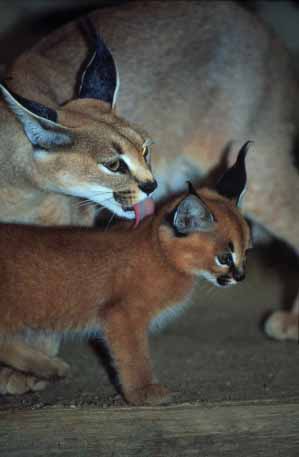Quote:
|
Jeanette reminds me of the class of posters we had when the ezboard first started and the mock was kinda clique-y. And it was generally nice people and a majority of females just being friendly.
|
I'm glad the forum isn't as cliquey anymore. And it's nice to know that my posts are appreciated.

Anyway, more cats!

Caracal (
Caracal Caracal)
The Caracal is sometimes referred to as a "desert lynx", but is not actually a member of the lynx genus. They were once tamed and trained for bird hunting by the nobility of Iran and India. They were put into areas containing a flock of pigeons, and wagers were taken as to how many they would kill. The caracal is capable for leaping into the air and taking down 10-12 birds at once! This practice is the origin of the expression "to put a cat among pigeons". One the distinctive features of this cat is its large ears, which have the black tufts that make it resemble the lynx, and are black on the back of them. In fact, their name comes from the Turkish word "karakulak", which means "black ear". Caracals are generally tawny brown to brick red in coloration, although black caracals have been recorded.Caracals live in the drier savannah and woodland regions of sub-Saharn Africa, and areas of the Middle East. They generallyprefer the more scrubby, arid habitats, although they will also inhabit evergreen and montane forests.

Serval (
Leptailurus serval) (Daphne this ones for you!

)
The serval is generally found in most parts of Africa excluding the arid desert regions to the north around the Sahara, parts of the western tip of Southern Africa and certain areas of the tropical rainforest belt of Central Africa. It lives in dry open plain grasslands through woodland savanna, moister areas around the equatorial rainforests and grassy uplands of central Africa’s mountainous regions. Although the serval is a medium size cat, it tends to eat smaller animals, such as rodents, birds, and frogs.The serval is a specialised hunter and has particularly sophisticated hearing to assist it in its task of pinpointing its small prey. It has large ears which are are used to listen to ultrasonic frequences emitted by small rodents. The long legs of the serval also serve to aid prey detection, enabling the cat to see over the tall savannah grasses for signs of movement. The serval is often observed giving a characteristic vertical leap to pounce down directly onto its unsuspecting quarry. In short bursts the cat is also able to reach high speeds and is capable of jumping up to 10 feet of the ground to catch birds.

Clouded Leopard (
Neofelis nebulosa)
The Clouded Leopard lives in Southeast Asia. Despite its name, it isn't actually a leopard at all, but of another genus of cat entirely. Little is known of clouded leopards due to their extremely secretive nature.They are thought to hunt a variety of prey including birds, squirrels, monkeys, deer, and wild pigs. It was once thought that clouded leopards hunted while climbing. Current thought, however, is that while some hunting may occur in the trees, most likely takes place on the ground. Trees are thought to provide resting habitat for cloudeds during the day.

Eurasian Lynx and cub (
Lynx Lynx)
This larger relative of the Canada lynx is found in the regions of central Asia and the former Soviet Union, as well as in scatter clusters in western Europe. They are found in both rocky terrian and forest areas. They are also not as dependent on the rabbit and the hare as the other lynxes, sometimes eating deer instead. They are solitary, and are sly and secretive. Eurasian lynx spend time grooming themselves in order to keep clean and scratch on surface in order to keep their claws sharp. They are most active in early morning and late afternoon. They hunting using their hearing and sight, rather than smell.
